ABSTRACT:
This report summarizes the results of the first two meetings of the Arizona-New
Mexico Jaguar Conservation Team (JAG Team) Research Committee and outlines future
research that will guide the JAG Team in sound conservation management of jaguars in
the United States. Research objectives were identified and approved by the JAG Team.
These objectives are to describe and quantify (1) the current distribution and (2) habitat
requirements of jaguars in southeastern Arizona and southwestern New Mexico. The
second meeting focused on selecting study methods to achieve these objectives.
The Borderlands Jaguar Detection Project has been conducting noninvasive
jaguar research in southeastern Arizona since 1999. There is great need to expand upon
the current research by conducting similar noninvasive presence/absence surveys in
adjacent mountain ranges with potential jaguar habitat in southeastern Arizona and
southwestern New Mexico. It is also necessary to gather more detailed data on jaguar
habitat selection in the Borderlands Region. Home range size, composition of habitat
types, travel routes, movement patterns, and diet are currently unknown for jaguars in the
northern extent of their range. This type of information is critical for the JAG Team to
successfully manage for healthy jaguar conservation in the American Southwest.
After virtual extirpation from the Southwest during the mid-1900’s, jaguars have
been rediscovered in portions of their former range in the United States, changing the
way we think about their current status and distribution. However, we must look ahead
and take the next step towards responsible jaguar conservation and apply serious, indepth
and objective research on the jaguar in the borderlands region. We emphasize the
unique situation of wild jaguars currently occupying portions of southeastern Arizona and
recommend investigations to learn as much as possible on the specific habitat selection
and habitat requirements of these jaguars while the opportunity exists. We propose a
combination of studies. These would include noninvasive presence/absence surveys to
determine the current status and distribution. Once jaguars are located, we recommend
conducting detailed studies of their habitat selection and ecology using a combination of
GPS telemetry and noninvasive monitoring techniques.

Reports and other documents about Sonoran Desert ecology, management, and conservation. Curated by the not-for-profit Altar Valley Conservation Alliance (AVCA) located outside Tucson, AZ.